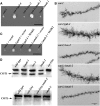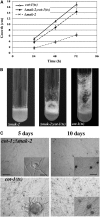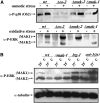The nuclear Dbf2-related kinase COT1 and the mitogen-activated protein kinases MAK1 and MAK2 genetically interact to regulate filamentous growth, hyphal fusion and sexual development in Neurospora crassa
- PMID: 18562669
- PMCID: PMC2475735
- DOI: 10.1534/genetics.108.089425
The nuclear Dbf2-related kinase COT1 and the mitogen-activated protein kinases MAK1 and MAK2 genetically interact to regulate filamentous growth, hyphal fusion and sexual development in Neurospora crassa
Abstract
Ndr kinases, such as Neurospora crassa COT1, are important for cell differentiation and polar morphogenesis, yet their input signals as well as their integration into a cellular signaling context are still elusive. Here, we identify the cot-1 suppressor gul-4 as mak-2 and show that mutants of the gul-4/mak-2 mitogen-activated protein (MAP) kinase pathway suppress cot-1 phenotypes along with a concomitant reduction in protein kinase A (PKA) activity. Furthermore, mak-2 pathway defects are partially overcome in a cot-1 background and are associated with increased MAK1 MAPK signaling. A comparative characterization of N. crassa MAPKs revealed that they act as three distinct modules during vegetative growth and asexual development. In addition, common functions of MAK1 and MAK2 signaling during maintenance of cell-wall integrity distinguished the two ERK-type pathways from the p38-type OS2 osmosensing pathway. In contrast to separate functions during vegetative growth, the concerted activity of the three MAPK pathways is essential for cell fusion and for the subsequent formation of multicellular structures that are required for sexual development. Taken together, our data indicate a functional link between COT1 and MAPK signaling in regulating filamentous growth, hyphal fusion, and sexual development.
Figures







Similar articles
-
Two NDR kinase-MOB complexes function as distinct modules during septum formation and tip extension in Neurospora crassa.Mol Microbiol. 2009 Nov;74(3):707-23. doi: 10.1111/j.1365-2958.2009.06896.x. Epub 2009 Sep 28. Mol Microbiol. 2009. PMID: 19788544 Free PMC article.
-
Role of a mitogen-activated protein kinase pathway during conidial germination and hyphal fusion in Neurospora crassa.Eukaryot Cell. 2004 Apr;3(2):348-58. doi: 10.1128/EC.3.2.348-358.2004. Eukaryot Cell. 2004. PMID: 15075265 Free PMC article.
-
WSC-1 and HAM-7 are MAK-1 MAP kinase pathway sensors required for cell wall integrity and hyphal fusion in Neurospora crassa.PLoS One. 2012;7(8):e42374. doi: 10.1371/journal.pone.0042374. Epub 2012 Aug 3. PLoS One. 2012. PMID: 22879952 Free PMC article.
-
Cell fusion in Neurospora crassa.Curr Opin Microbiol. 2015 Dec;28:53-9. doi: 10.1016/j.mib.2015.08.002. Epub 2015 Sep 3. Curr Opin Microbiol. 2015. PMID: 26340439 Review.
-
Cell fusion in the filamentous fungus, Neurospora crassa.Methods Mol Biol. 2008;475:21-38. doi: 10.1007/978-1-59745-250-2_2. Methods Mol Biol. 2008. PMID: 18979236 Review.
Cited by
-
Three Fusarium oxysporum mitogen-activated protein kinases (MAPKs) have distinct and complementary roles in stress adaptation and cross-kingdom pathogenicity.Mol Plant Pathol. 2017 Sep;18(7):912-924. doi: 10.1111/mpp.12446. Epub 2016 Sep 29. Mol Plant Pathol. 2017. PMID: 27301316 Free PMC article.
-
Accumulation of specific sterol precursors targets a MAP kinase cascade mediating cell-cell recognition and fusion.Proc Natl Acad Sci U S A. 2016 Oct 18;113(42):11877-11882. doi: 10.1073/pnas.1610527113. Epub 2016 Oct 5. Proc Natl Acad Sci U S A. 2016. PMID: 27708165 Free PMC article.
-
A non-Mendelian MAPK-generated hereditary unit controlled by a second MAPK pathway in Podospora anserina.Genetics. 2012 Jun;191(2):419-33. doi: 10.1534/genetics.112.139469. Epub 2012 Mar 16. Genetics. 2012. PMID: 22426880 Free PMC article.
-
The GUL-1 Protein Binds Multiple RNAs Involved in Cell Wall Remodeling and Affects the MAK-1 Pathway in Neurospora crassa.Front Fungal Biol. 2021 Apr 16;2:672696. doi: 10.3389/ffunb.2021.672696. eCollection 2021. Front Fungal Biol. 2021. PMID: 37744127 Free PMC article.
-
Coordinated Regulation of Protoperithecium Development by MAP Kinases MAK-1 and MAK-2 in Neurospora crassa.Front Microbiol. 2021 Nov 26;12:769615. doi: 10.3389/fmicb.2021.769615. eCollection 2021. Front Microbiol. 2021. PMID: 34899653 Free PMC article.
References
-
- Bahn, Y. S., C. Xue, A. Idnurm, J. C. Rutherford, J. Heitman et al., 2007. Sensing the environment: lessons from fungi. Nat. Rev. Microbiol. 5 57–69. - PubMed
-
- Bistis, G. N., D. D. Perkins and N. D. Read, 2003. Different cell types in Neurospora crassa. Fungal Genet. Newsl. 50 17–19.
Publication types
MeSH terms
Substances
LinkOut - more resources
Full Text Sources
Miscellaneous

